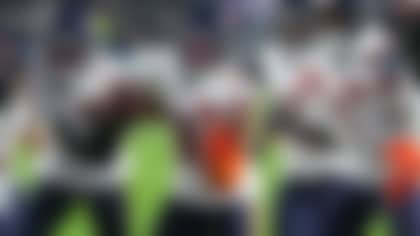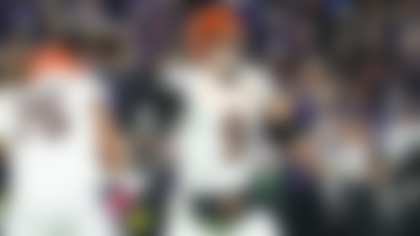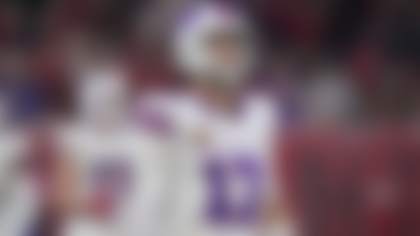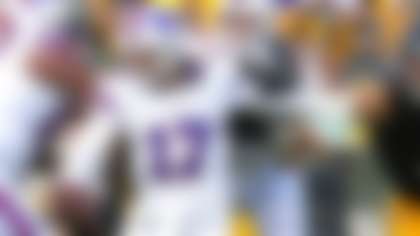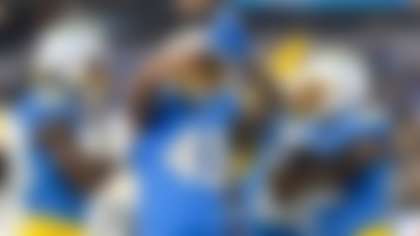The lack of quality quarterbacks in the NFL entices every general manager and head coach to kick the tires on any signal caller who initially was regarded as a top talent coming out of school. When I worked as a scout for the Seattle Seahawks under Mike Holmgren, I watched the offensive guru repeatedly bring in former first-round quarterbacks to see if he could salvage their careers. We not only brought in Trent Dilfer (sixth overall pick, 1994) as a backup/potential starter, but we also signed Ryan Leaf (second overall pick, 1998) to see if we could help him reach his potential as a player.
I watched Hall of Fame inductee Ron Wolf use a similar strategy during my time as a player in Green Bay -- Holmgren was the head man on a team that also featured future NFL head coaches Andy Reid, Steve Mariucci, Marty Mornhinweg and Doug Pederson -- which is why I'm never surprised when teams take chances on highly drafted prospects who underperform with their original teams. With quarterbacks, in particular, a change of scenery can unlock their potential as playmakers.
Considering the number of former top quarterback prospects attempting to rebuild their respective careers in new environments, I believe it is the right time to take a look at how Mark Sanchez, Blaine Gabbert and Robert Griffin IIIcould bounce back in 2016.
Mark Sanchez, Denver Broncos
Fifth overall pick in the 2009 NFL Draft
What went wrong in New York and Philadelphia?
It is hard to call Sanchez's tenure in New York a complete failure -- based on the team's back-to-back AFC Championship Game appearances during his first two seasons -- but he certainly didn't play up to standard during his five-year run on Broadway. The eighth-year pro was a turnover machine as the team's starter (69 interceptions and 20 fumbles in 62 starts) and struggled with his accuracy as a pocket passer (Sanchez never completed over 60 percent of his passes in a single season as the Jets' starter). Despite being surrounded by a strong supporting cast on both sides of the ball, Sanchez never figured out to thrive as a "game manager" and his inability to avoid costly mistakes in key moments prevented the Jets from reaching their potential under Rex Ryan.
In Philadelphia, Sanchez showed promise as an occasional starter under Chip Kelly. He was more efficient and effective directing the Eagles' up-tempo offense, as evidenced by his completion percentage (64.2 percent in 10 starts) and passer rating (posted a career-best 88.4 rating in eight starts in 2014). Most impressively, he showed the kind of big-play ability that he rarely flashed in New York. In 2014, Sanchez posted a career-best 7.8 yards per attempt on the strength of 34 20-yard plus passes and six 40-yard plus completions, which nearly matched his career highs in both categories despite significantly fewer snaps.
Yet, Sanchez continued to struggle with turnovers (15 interceptions and four fumbles) during his time with the Eagles, and his inconsistent play in big games raised serious concerns about his ability to lead a championship-caliber team.
Why will he succeed in Denver?
Sanchez walks into the ideal situation as a starting quarterback. The Broncos not only have a championship-caliber defense that is capable of fueling another Super Bowl run, but he is surrounded by a pair of Pro Bowl pass catchers (Emmanuel Sanders and Demaryius Thomas) that should make life easier for the veteran QB. Sanders is a dynamic route runner with the speed, quickness and burst to create significant separation from defenders on short and intermediate throws. In addition, he is a dangerous runner in the open field, which makes him a big-play threat on catch-and-run passes.
Blaine Gabbert, San Francisco 49ers
10th overall pick in the 2011 NFL Draft
What went wrong in Jacksonville?
It is easy to blame the player when things go awry, but Gabbert's failure should be pinned squarely on the Jaguars and their poor development plan. The sixth-year pro never should've touched the field as a rookie based on his limited football experience (entered the 2011 draft after only 26 collegiate starts) and the difficult transition from the spread offense to a traditional pro-style system. Yet, the Jaguars trotted out the 22-year-old passer as a 14-game starter before he had a grasp of the offense, the fundamentals of the position (footwork and mechanics) and the complexities of defensive fronts and coverage.
Now, it is important to remember that Jack Del Rio was fighting for his coaching life at the time and finding a young franchise quarterback would serve as a life preserver for the embattled coach. Thus, the Jaguars rushed Gabbert onto the field before he was ready, and his confidence suffered as a result. The former Missouri standout never appeared to be comfortable in the pocket, and his anxiety led his eyes to focus on the pass rush instead of his downfield receivers. With Gabbert looking shaky and unsettled in the pocket, critics openly questioned his courage and toughness despite his inexperience and lackluster supporting cast (offensive line and receivers).
In his second season, Gabbert showed some improvement as a passer and playmaker under Mike Mularkey, before a torn labrum (left shoulder) prematurely ended his season after 10 starts. In a start against the Green Bay Packers, in particular, Gabbert looked like a franchise quarterback, completing 27 of his 49 pass attempts for 303 yards with a touchdown. Although the standout performance came in a losing effort, it was a solid building block for a quarterback who struggled mightily during his first few seasons in Jacksonville.
With administration and coaching changes heading into the 2013 season, Gabbert was forced to learn his third offensive scheme in three years, and the instability certainly hindered his development as a potential franchise quarterback. Thus, he was never able to fully focus on his fundamentals and mechanics as a passer during the offseason because he spent the bulk of his time learning the nuances of a new offense. After suffering another injury (broken thumb) in training camp, Gabbert was relegated to backup duties during his final season with the Jaguars before the team traded him to San Francisco for a sixth-round pick the following offseason.
Why will he succeed in San Francisco?
Blaine Gabbert is a vastly improved player from the young gunslinger who struggled in Jacksonville. He is a more confident player after putting together a solid 2015 campaign where he completed 63.1 percent of his passes and compiled a 86.2 passer rating. Although numbers can be misleading when it comes to evaluation, there's no disputing his improved accuracy, timing and touch when evaluating the tape from last season. Gabbert routinely delivered accurate strikes to receivers on the perimeter despite playing behind a leaky offensive line that provided poor pass protection at the line of scrimmage (49ers allowed 25 sacks in Gabbert's eight starts). Most impressively, Gabbert showed observers that he could play winning football by making critical plays in key moments in the team's wins over Atlanta, Chicagoand St. Louis.
Considering Gabbert's growth as a passer and playmaker since his arrival in San Francisco, the 49er faithful should be optimistic about his chance of blossoming into a franchise quarterback under Chip Kelly. Despite his unceremonious departure from Philadelphia, Kelly showed the ability to maximize the talents of the quarterbacks at his disposal by implementing a QB-friendly system that plays to the strength of the team's personnel. Nick Foles, a former third-round pick with athletic limitations, played at an MVP level (completed 64 percent of his passes with a 27:2 touchdown-to-interception ratio for a 119.2 passer rating) in his first season under Kelly.
The offensive wizard cleverly blended a rapid tempo pace with a simplistic passing game that allowed the Philly quarterbacks to attack static defenses forced to play vanilla coverage in the back end. Sam Bradford and Mark Sanchez also enjoyed solid runs under Kelly (see: Sanchez's 2014 season and Bradford's last seven starts of 2015) as the directors of an offense that emphasizes a handful of passing concepts (six to eight route combinations) from a variety of formations and personnel groupings. The scheme also allows quarterbacks to execute the same series of triangle or multi-levels reads with different players running the routes from multiple formations.
In San Francisco, Kelly will be able to enhance Gabbert's skills by utilizing some zone-read and RPO (run/pass option) concepts to keep the defense off balance. The 6-foot-4, 235-pound quarterback is a slippery athlete capable of delivering big plays on the perimeter as a run/pass threat. Thus, Kelly can use Gabbert as a runner on zone-read plays, quarterback runs or bootleg passes. Those plays will not only enhance the 49ers' running game, but they will create bigger windows for the quarterback to exploit on play-action passes.
With Gabbert enjoying a slight advantage over his competitors (Colin Kaepernick and Jeff Driskel) as a more accurate passer, the arrival of Kelly could help the veteran rejuvenate his career.
Robert Griffin III, Cleveland Browns
Second overall pick in 2012 NFL Draft
What went wrong in Washington?
It is hard to believe a player capable of winning the 2012 Offensive Rookie of the Year award could flame out so quickly and in such an epic fashion, but that's exactly what happened to Griffin in Washington. The one-time Pro Bowler failed to build on a spectacular rookie season that led me to believe he could revolutionize the position with his combination of athleticism, running skills and playmaking ability.
After shining in a read-option offense that allowed him to maximize his electrifying talents as a dual-threat playmaker (Griffin posted a 20:5 touchdown-to-interception ratio and rushed for 815 yards as a rookie), Griffin reportedly asked the team to eliminate the zone-read and quarterback runs in favor of a more traditional offense that features a dropback passing game. The decision was an absolutely awful move for the young quarterback, given his limitations as a passer. Griffin spent his developmental years in high school and at Baylor directing a spread offense that didn't require disciplined footwork or an advanced understanding of complex passing concepts. Thus, he asked to play in an offense that played to his weaknesses instead of his strengths as a passer and playmaker.
In addition to Griffin's self sabotage, the Redskins didn't help their young passer by bringing in a head coach who was unwilling or incapable of tweaking his system to suit the skills of the franchise quarterback. As a proponent of a traditional pro-style offense, Jay Gruden requires the quarterback to execute pure progression reads to move the ball in the passing game. The quarterback must be able to quickly diagnose coverage and work a designated side of the field based on his reads. This demands outstanding vision, awareness and disciplined footwork from the quarterback. Most importantly, he must be a quick decision maker capable of making accurate throws at short and intermediate range.
With Griffin unable to fit the job description as a passer and playmaker in a traditional offense that requires the quarterback to win with his arm, the fifth-year pro was destined to fail as a starter in Washington.
Why will he succeed in Cleveland?
Hue Jackson's reputation as one of the best quarterback developers in the NFL makes it plausible to expect Griffin to bounce back as a franchise quarterback in Cleveland. The ultra-confident coach is an imaginative schemer willing to tailor his system around the talents of his quarterback. Jackson helped Andy Dalton blossom as a playmaker in Cincinnati by implementing several concepts from a collegiate playbook that mirrored some of his young passer's favorite plays at TCU. From featuring a shotgun passing game to mixing in some zone-read plays, Jackson put Dalton in his comfort zone by crafting an offense that fit like an old glove.
In addition, he added a handful of creative tactics (unbalanced offensive line, odd-ball formations and trick plays) that put defenders in compromising positions on the field. With Dalton adept at reading defensive fronts and coverage, the creative scheming created big-play opportunities for a quarterback pegged as a "game manager." Considering Jackson's impressive work with other quarterbacks (see: Carson Palmer, Joe Flacco, Jason Campbell and AJ McCarron), the Browns should expect Griffin to make a significant jump as a player.
Looking at the Jackson-Griffin marriage, the Browns likely will build the offense around a strong run game and a vertical aerial attack. The presence of a dominant ground game will force opponents to use more eight-man fronts, leading to one-on-one coverage on the outside. In addition, the threat of a hard-hitting running will create some opportunities for Griffin to use his legs on designed quarterback runs or zone-read concepts despite any objections from the quarterback.
In the passing game, Griffin's strong arm and athleticism will allow Jackson to feature a vertical passing attack that uses play-action (traditional play-action and bootleg passes) to lure safeties to the line of scrimmage. With second-level defenders forced to respect the running game and Griffin's athleticism, the Browns' speedy receivers (especially rookie Corey Coleman) could feast on isolated coverage on the perimeter.
If Griffin buys in to Jackson's philosophy and adheres to the tenets of the system, he could re-emerge as the dual-threat playmaker who took the NFL by storm as a young player.
Follow Bucky Brooks on Twitter @BuckyBrooks.

